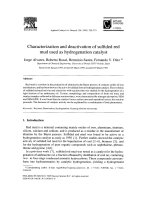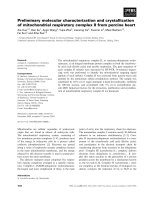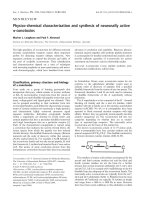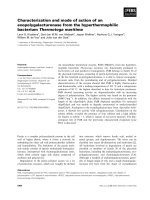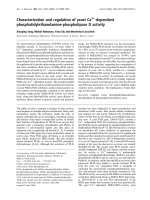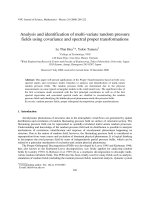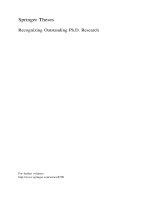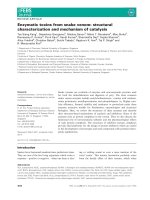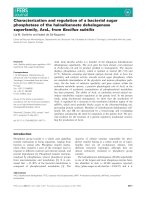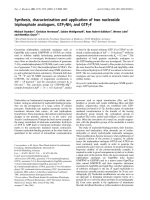Characterization and identification of actinomycetes capable of antagonism with fungus colletotrichum gloeosporioides cause anthracnose disease in plants (khóa luận tốt nghiệp)
Bạn đang xem bản rút gọn của tài liệu. Xem và tải ngay bản đầy đủ của tài liệu tại đây (2.75 MB, 75 trang )
VIETNAM NATIONAL UNIVERSITY OF AGRICULTURE
FACULTY OF BIOTECHNOLOGY
--------------
GRADUATION THESIS
CHARACTERIZATION AND IDENTIFICATION OF
ACTINOMYCETES CAPABLE OF ANTAGONISM
WITH FUNGUS COLLETOTRICHUM
GLOEOSPORIOIDES CAUSE ANTHRACNOSE
DISEASE IN PLANTS
HÀ NỘI - 2022
VIETNAM NATIONAL UNIVERSITY OF AGRICULTURE
FACULTY OF BIOTECHNOLOGY
--------------
GRADUATION THESIS
CHARACTERIZATION AND IDENTIFICATION OF
ACTINOMYCETES CAPABLE OF ANTAGONISM
WITH FUNGUS COLLETOTRICHUM
GLOEOSPORIOIDES CAUSE ANTHRACNOSE
DISEASE IN PLANTS
Student name
Class
Student 's code
Supervisor
Department
: NGUYEN MAI ANH
: K62CNSHE
: 620453
: Dr. TRINH XUAN HOAT
Assoc. Prof. Dr. NGUYEN XUAN CANH
: MICROBIAL TECHNOLOGY
HÀ NỘI - 2022
COMMITMENT
I hereby commit that the thesis is completely done by me under the
guidance of Assoc. Prof. Dr. Nguyen Xuan Canh, Trinh Xuan Hoat, PhD. All
the data and results that I have provided in this study are true, accurate, and not
used in any other report. I also assure that the literatures cited in the thesis
indicated the origin and all help was thankful.
Hanoi, March 2022
Student
Nguyen Mai Anh
i
ACKNOWLEDGEMENTS
First of all, I want to express my sincere thanks to the Microbial
Technology Department, Faculty of Biotechnology, and Vietnam National
University of Agriculture because this thesis would not have been possible
without the involvement and support of the assistance and guidance of dedicated
teachers at the laboratories of the Department.
First and foremost, I pay my deep sense of gratitude to my principal
supervisors Assoc. Prof. Dr. Nguyen Xuan Canh, Trinh Xuan Hoat, PhD who
encouraged me to complete my thesis and gave me lots of advice.
I would like to thank all staff and students at the Laboratory of the
Department of Microbial Technology, especially Mrs. Nguyen Thi Thu for
helping and creating favorable conditions for me during the graduation thesis.
They were all very friendly and helpful to me, I was lucky to study and work in
a great environment.
Last but not the least, my family is also an important inspiration for me.
So with due regards, I express my gratitude to them.
Thank you sincerely!
Hanoi, March 2022
Student
Nguyen Mai Anh
ii
INDEX
COMMITMENT .................................................................................................... i
ACKNOWLEDGEMENTS .................................................................................. ii
LIST OF TABLES ................................................................................................ v
LIST OF FIGURES .............................................................................................. vi
LIST OF ABBREVIATIONS ............................................................................. vii
ABSTRACT ....................................................................................................... viii
PART 1. INTRODUCTION ................................................................................. 1
1.1. Introduction .................................................................................................... 1
1.2. Purposes and requirements ............................................................................. 3
1.2.1. Purposes ...................................................................................................... 3
1.2.2. Requirements ............................................................................................... 3
PART II. LITERATURE REVIEW ...................................................................... 4
2.1. Overview of Actinomycetes ........................................................................... 4
2.1.1. Introduction and distribution of Actinomycetes ......................................... 4
2.1.2. Classification of Actinomycetes ................................................................. 5
2.1.3. Morphological characteristics of Actinomycetes ........................................ 6
2.1.4. Structure of Actinomycetes ....................................................................... 12
2.1.5. The roles and applications of Actinomycetes ........................................... 12
2.2. Overview of Colletotrichum gloeosporioides .............................................. 19
2.2.1. Introduction of Colletotrichum gloeosporioides ....................................... 19
2.2.2. Biology of Colletotrichum gloeosporioides infection process ................. 21
2.2.3.
Damage
of
Anthracnose
disease
caused
by
Colletotrichum
gloeosporioides in agriculture ............................................................................. 23
PART III. MATERIALS AND METHODS....................................................... 26
3.1. Materials ....................................................................................................... 26
3.1.1. Materials .................................................................................................... 26
3.1.2. Chemicals, instruments and equipment .................................................... 26
3.1.3. Experiment location and time ................................................................... 28
3.2. Methods ........................................................................................................ 28
iii
3.2.1. Activate Actinomycetes strains preserved in glycerol .............................. 28
3.2.2. Screening of Actinomycetes with antifungal activity ............................... 28
3.2.3. Morphological characterizations of Actinomycetes ................................. 29
3.2.4. Ability to assimilate carbon sources ......................................................... 30
3.2.5. Ability to produce extracellular enzymes ................................................. 30
3.2.6. Effects of temperature, pH and NaCl concentrations on the growth of
Actinomycetes ..................................................................................................... 31
3.2.7. Ability to utilize citrate ............................................................................. 31
3.2.8. Ability to hydrolyze gelatin ...................................................................... 32
3.2.9. Ability to decompose urea ........................................................................ 32
3.2.10. Classification of the Actinomycetes based on 16S rRNA sequences ..... 33
PART IV. RESULTS AND DISCUSSION ........................................................ 36
4.1. Screening and selection of fungal antagonist Actinomycetes ..................... 36
4.2. Morphological characteristics ...................................................................... 37
4.3. Ability to assimilate carbon sources ............................................................ 40
4.4. Ability to produce extracellular enzymes .................................................... 42
4.5. Effects of temperature, pH and NaCl concentrations on the growth of
Actinomycetes ..................................................................................................... 44
4.6. Ability to utilize citrate ................................................................................ 46
4.7. Ability to hydrolyze gelatin ......................................................................... 47
4.8. Ability to decompose urea ........................................................................... 48
4.9. Classification of the Actinomycetes based on 16S rRNA sequences .......... 49
4.9.1. Total DNA extraction and concentration .................................................. 49
4.9.2. Amplification of 16S rRNA sequences ..................................................... 50
4.9.3. Sequencing PCR products and building a phylogenetic tree .................... 51
PART V. CONCLUSIONS AND PROPOSALS ............................................... 53
5.1. Conclusions .................................................................................................. 53
5.2. Proposals ...................................................................................................... 53
REFERENCES .................................................................................................... 54
APPENDIX ......................................................................................................... 59
iv
LIST OF TABLES
Table 3. 1. Primers for PCR ............................................................................... 34
Table 3. 2. Components of PCR reaction........................................................... 35
Table 4. 1. Colony morphology of Actinomycetes strain VNUA48 in ISP field 38
Table 4. 2. Assimilation of different carbon sources of Actinomycetes strain
VNUA48 ............................................................................................................ 42
Table 4. 3. Effects of environmental conditions on the growth of Actinomycetes
strain VNUA48 .................................................................................................. 44
v
LIST OF FIGURES
Figure 2. 1. Single spore production in short chains .............................................8
Figure 2. 2. Morphological features of spores. .................................................. 10
Figure 2. 3. Spore production within sporangia. ................................................ 11
Figure 4. 1. Screening fungal antagonist Actinomycetes: Control fungus (A),
Dual cultured Actinomycetes (B) after 7 days of culture ................................... 36
Figure 4. 2. Colony morphological characteristics of Actinomycetes VNUA48 in
ISP field after 7 days of culture.......................................................................... 37
Figure 4. 3. Mycelia and spore chains morphology after 50 hours of culture (A),
Spore chain and spore morphology after 72 hours of culture (B) ..................... 39
Figure 4. 4. Actinomycetes strain VNUA48 on ISP 6 medium after 7 days of
culture ................................................................................................................. 40
Figure 4. 5. Growth of Actinomycetes strain VNUA48 on: positive control (A),
negative control (B), and basal medium containing starch (C) ......................... 41
Figure 4. 6.
Ability to produce Amylase, Cellulase, Chitinase, Pectinase,
Protease, Catalase of strain VNUA48 after 7 days of culture............................ 43
Figure 4. 7. Citrate utilization test of strain VNUA48: Negative control tube (A),
test tube containing strain VNUA48 (B)............................................................ 46
Figure 4. 8. Gelatin hydrolysis test of Actinomycetes strain VNUA48: Negative
control tube (A), test tube containing Actinomycetes strain VNUA48 (B)....... 47
Figure 4. 9. Urea decomposition test: Negative control tube (A), test tube
containing Actinomycetes strain VNUA48 (B) ................................................. 49
Figure 4. 10. Gel electrophoresis of total DNA extraction off Actinomycetes
strain VNUA48 .................................................................................................. 50
Figure 4. 11. Gel electrophoresis of PCR product of Actinomycetes strain
VNUA48 ............................................................................................................ 50
Figure 4. 12. Phylogenetic tree of Actinomycetes strain VNUA48 .................. 51
vi
LIST OF ABBREVIATIONS
Abbreviation
C. gloeosporioides
Meaning
Colletotrichum gloeosporioides
cAMP
Cyclic Adenosine Monophosphate
ISP
International Streptomyces Project
PDA
Potato Dextrose Agar
DNA
Deoxyribonucleic acid
NCBI
National Center for Biotechnology Information
PCR
Polymerase Chain Reaction
rRNA
Ribosome RNA
pH
Power of hydrogen/potential of hydrogen
R
Reverse
F
Forward
vii
ABSTRACT
The main object of this study is to screening and characterization
Actinomycetes capable of antagoním with pathogenic fungus Colletotrichum
gloeosporioides causing anthracnose disease in plants. Thirty Actinomycetes
were activated from preservation at the Department of Microbial Technology,
Faculty of Biotechnology, Vietnam National University of Agriculture. Dual
culture method was used to screen and select potential antagonistic
Actinomycetes. The Actinomycetes strain VNUA48 with the inhibition rate was
51.11% was selected to study morphological and biochemical characteristics.
Then, this Actinomycetes strain was evaluated that it has ability to utilize carbon
sources, produce melanin pigment, grow on different culture conditions, utilize
citrate, hydrolyze gelatin, and decompose urea. This Actinomycetes strain was
further extracted with total DNA, ran a 16S rRNA gene sequence reaction
(PCR) using primers 27F and 1492R, then sequenced and built a phylogenetic
tree. Based on the morphological, biochemical and 16S rRNA gene sequences,
Actinomycetes strain VNUA48 which antagonizes the fungus Colletotrichum
gloeosporioides has close relative to Streptomyces sp. strain PSKA49.
viii
PART 1. INTRODUCTION
1.1. Introduction
Colletotrichum is a large genus including a plenty of important species
that are among the most popular fungal pathogens causing diseases in various
fruits and crops. A majority of every crop grown throughout the world is
susceptible to one or more species of Colletotrichum. Recently, the genus
Colletotrichum was the eighth most significant group of phytopathogenic fungi in
the world (Dean 2012).
Colletotrichum gloeosporioides and the anthracnose disease cause
mounting threat to global agriculture. This fungus causes bitter rot in variety of
crops worldwide, from monocotyledons to higher dicothyledons (Bailey, 1992).
Colletotrichum species lead to losses of more than 50% fresh fruit and
vegetables productivities
(Paull, 1997). Some of the important host plants
include citrus, yam, papaya, avocado, coffee, eggplant, sweet pepper, and
tomato. It results in a dramatic amount of pre- and post-harvest losses in these
crops worldwide. This fungus acts as a secondary invader of injured tissue or
survives as a saprophyte.
Colletotrichum gloeosporioides involve various
symptoms depending on the host species and tissue infected. There are black or
brown lesions in the infected fruits, while blight, necrosis, and lesions with
flecks and streaks appear in the inflorescence. Abnormal colors and patterns
with dark, necrotic, angular, or irregular areas are observed in the infected
leaves. Infection on the stems produces dieback and discoloration with
gummosis and resinosis.
Many solutions are applied in plant protection to decrease the harm
caused by fungal diseases. However, chemical measures have their limitations
such as drug resistance in harmful agents, increase in environmental pollution,
ecological imbalance, and chemical residues in the soil, endanger human health.
1
Therefore, biological-origin fungicides are a good way to overcome the
limitations of chemical measures in the protection of plants from harmful fungi.
Actinomycetes are prominent for their ability to produce secondary metabolites,
many of which have antibacterial and antifungal properties (Sabaratnam &
Traquair, 2002; Minuto et al., 2006). Actinomycetes have the ability to
manufacture an abundance of extracellular hydrolytic enzymes (Mccarthy &
Williams, 1992; Schrempf, 2001), particularly in the soil, where they are
responsible for the breakdown of dead plants, animals, and fungal materials.
They also play an important role in soil biodegradation and humus formation
because of their ability to recycle the nutrients associated with recalcitrant
polymers, such as chitin, keratin, and lignocelluloses (Goodfellow & Williams,
1983; Mccarthy & Williams, 1992; Stach & Bull, 2005). The bioactive
secondary metabolites produced by microorganisms is reported to be around
23,000 of which 10,000 are produced by Actinomycetes, thus representing 45%
of all bioactive microbial metabolites discovered (Berdy, 2005). Among
Actinomycetes, approximately 7,600 compounds are produced by Streptomyces
species (Berdy, 2005). Consequently, there has been an upward trend from
actively pursuing research centers that have made their screening programs more
intensive, resulting in a growing number of reports of novel active compounds.
Their characterizations are based on morphological and physiological criteria
revealed by many laboratory tests. In this research, I study about the topic:
"Characterization and identification of Actinomycetes capable of antagonism
with fungus Colletotrichum gloeosporioides cause Anthracnose disease in
plants".
2
1.2. Purposes and requirements
1.2.1. Purposes
- Characterization and identification of Actinomycetes capable of
antagonism with fungi Colletotrichum gloeosporioides cause Anthracnose
disease in plants.
1.2.2. Requirements
- Screen Actinomycetes strain with ability of resistant to fungus
Colletotrichum gloeosporioides cause anthracnose disease in plants.
- Study morphological and biochemical characteristics of selected
Actinomycetes train.
- Classify and identify Actinomycetes strain based on 16S rRNA
sequences.
3
PART II. LITERATURE REVIEW
2.1. Overview of Actinomycetes
2.1.1. Introduction and distribution of Actinomycetes
Streptothrix foersteri, described by Ferdinand Cohn in 1875, and
Actinomyces bovis, described by Carl Otto Harz in 1877, were two of the first
Actinobacteria described. Harz described Actinomycetes bovis, which causes the
'lumpy jaw' sickness in cattle, as having thin filaments that ended in club-shaped
structures resembling those of fungi, hence the name Actinomyces (Latin for ray
fungus). The 'gonidia,' on the other hand, very definitely housed cells, and so the
resemblance to ordinary fungi was misleading. Several other bacteria, including
the causative agents of leprosy and tuberculosis, were identified with some of
the same features and were assumed to belong to the same group as the ones
named above. Although their phylogenetic position as actual bacteria was not
proven until the 1960s, this group of organisms was officially classified as
Actinomycetales in 1916, and it became clear that they formed a big diverse
group with a wide range of physiological and biochemical features. The
Actinobacteria are today regarded one of the bacterial kingdom's largest phyla.
Some corynebacteria have a GC value of 54%, while Streptomycetes have a GC
content of more than 70%. The causal agent of Whipple's disease, Tropheryma
whipplei, has a GC content of 46.3%, which is the lowest known for
Actinobacteria. (Ul-Hassan, 2009).
The Actinomycetes are a well-defined group of bacteria with a high GC
content and a diverse variety of habitats. The group's members can be found in a
variety of habitats, including soil, rhizosphere, marine, and freshwater systems.
They are more common in soil than in other habitats, especially in alkaline and
organic-rich soils, where they make up a large portion of the microbial
community. Several are major human and animal pathogens, with only a few
4
being plant infections. The population density of Actinomycetes depends on the
living habitat and climatic circumstances; 1 gram of soil contains between 10 6
and 109 cells, most of which are streptomycetes (accounting for more than 95%
Actinomycetes in the soil). The great majority of Actinomycetes are crucial
saprophytes that can decompose a variety of plant and animal waste. Antibiotics,
enzymes, enzyme inhibitors, signaling molecules, and immunomodulators are
all produced prolifically by some genera, such as Streptomyces and
Micromonospora.
Actinomycetes, like other soil bacteria, are mostly thermophilic, with a
growth temperature of 25-30°C. Actinomycetes that grow at high temperatures
(50-60°C) and Actinomycetes that grow at low temperatures, such as
Arthrobacter ardleyensis identified from Antarctic lake sediments (0°C), are two
types of Actinomycetes (Chen et al., 2008). Actinomycetes thrive in lowhumidity soil; but, in dry soil or areas with more moisture, growth is restricted
and can be terminated. The majority of Actinobacteria thrive on soil with a
neutral. They thrive in a pH range of 6 to 9, with maximal growth occurring in this
range. Several Streptomyces strains, however, have been identified from acidic
soils (pH 3.5).
2.1.2. Classification of Actinomycetes
Actinomycetes are now characterized utilizing a polyphasic method,
which combines phenotypic, chemotaxonomic, and genotypic data to generate a
formal description of a new taxon. Tindall (2010) defined the important aspects
that should be obtained and assessed in prokaryote characterization studies:
phenotypic traits constitute the basis for taxonomic classification (Tindall et al.,
2010). In the first place, most actinobacteria are identified and categorized
based on their morphology. Morphological traits are still one of the most
fundamental indices for obtaining detailed information about a taxon.
5
Actinobacteria is one of the most diverse taxa of the 18 main phyla now
recognized in the bacterial kingdom, with five subclasses, 6 orders, and 14
suborders (Ludwig et al., 2012). The appearance, physiology, and metabolism of
this species' taxa are quite diverse. The Actinobacteria phylum was named from
its branching location in the taxon tree (using the 16S rRNA sequences). The
current explosion of genomic sequence data has brought new insights into the
development of the Actinobacteria genus. Therefore, the phylum Actinobacteria
is divided into six classes: Actinobacteria, Acidimicrobiia, Coriobacteriia,
Nitriliruptoria, Rubrobacteria and Thermoleophilia.
2.1.3. Morphological characteristics of Actinomycetes
Radial mycelium is extensively developed in Actinomycetes. Mycelia can
be classified into substrate mycelium and aerial mycelium based on
morphological and functional differences. Actinomycetes can produce spores,
spore chains, sporangia, and sporangiospores, among other forms. The location
of the spore, the quantity of spore, the surface properties of the spore, the form
of the sporangia, and whether or not the sporangiospores have flagella are all
essential morphological aspects of Actinomycetes classification.
Substrate mycelium
The substrate mycelium, which develops into the medium or on the
surface of the culture media, is essential for Actinomycetes to absorb nutrients.
Substrate mycelia are thin, translucent, phase-dark, and more branching than
aerial hyphae, according to their appearance under the microscope. The single
hyphae are roughly 0.4 to 1.2 µm thick, do not form diaphragms, and can
branch.
White, yellow, orange, red, green, blue, purple, brown, black, and other
hues are seen in substrate mycelia, and certain hyphae can create water- or fat-
6
soluble pigment. Water-soluble pigments can permeate into culture media,
resulting in a color-matched medium. The colony with the same color is made up
of non-water-soluble (or fat-soluble) pigments. The color of the substrate mycelia
and the presence of soluble pigments are crucial indicators for identifying new
species.
Aerial mycelium
The hyphae that the substrate mycelium develops to a particular stage and
grows into the air is known as aerial mycelium. Aerial hyphae and substrate
mycelia might be difficult to identify at times. A cover slip is used to distinguish
aerial hyphae from substrate mycelia, which is then seen in a dry environment
with a light microscope: substrate hyphae are thin, transparent, and phase-dark;
aerial hyphae are coarse, refractive, and phase-bright. Except for the genera
Pseudonocardia and Amycolata, the hyphae of aerial mycelium have a fibrous
coating. It is made up of fibrillar components and short rodlets that generate a
distinctive pattern under the microscope. The fibrous sheath is also present on
sporulation aerial hyphae, which accounts for the spore's many surface
ornamentations.
Aerial mycelium is the hyphae that the substrate mycelium develops to a
certain stage, and grows into the air. Sometimes, aerial hyphae and substrate
mycelia are difficult to distinguish. To distinguish aerial hyphae and substrate
mycelia, a cover slip is used then this slip is viewed in a dry system with a light
microscope: substrate hyphae are slender, transparent, and phase-dark; aerial
hyphae are coarse, refractive, and phase-bright. The hyphae of the aerial
mycelium are characterized by a fibrous sheath, except the genera
Pseudonocardia and Amycolata. Ultramicroscopic, it is composed of fibrillar
elements and short rodlets, forming a characteristic pattern. The fibrous sheath is
also present on sporulation aerial hyphae, causing the different surface
7
ornamentations of the spore. Species characteristics, nutritional circumstances,
and environmental factors all influence the formation of actinobacteria aerial
hyphae. Some genus' aerial mycelium reaches a specific stage in the top form
spore chain, which is a reproductive hyphae-producing spore.
Spore chain
Figure 2. 1. Single spore production in short chains
Monosporous:
(A)
Saccharomonospora,
Micromonospora,
(D)
(B)
Thermomonospora,
Thermoactinomyces.
Disporous:
(C)
(E)
Microbispora. Oligosporous: (F) Nocardia brevicatena, (G) Catellatospora.
Actinobacteria can develop reproductive hyphae called spore-bearing
mycelium after reaching a certain level of differentiation in its aerial hyphae.
Most actinobacteria genera have this sort of spore production. Observation has
revealed that spore chains may be classified visually based on the length and
quantity of spores: di- or bisporous with two spores, oligosporous with a few
8
spores, and polysporous with numerous spores. The length, shape, location, and
color of Actinomycetes spore chains are all used to classify the fungus.
Monosporous production refers to the production of a single spore. This
form is found in numerous suprageneric groups, including Micromonospora,
Thermomonospora, Saccharomonospora, and Thermoactinomyces, which are all
well-known genera. The disporous chain includes a longitudinal pair of spores
with indicative as genus Microbispora. The spores are placed on the aerial
hyphae directly or on extremely short side branches. Short spore chains are
produced by oligosporous Actinomycetes. The majority of the representatives
had between 7 and 20 spores per chain, with at least 3 spores.
Polysporous of Streptomyces create lengthy chains with more than 50
spores. Streptomyces spore chains have a variety of spore-bearing structures:
straight, flexous, fascicied, monovericillate (no spirals), open loops (primitive
spirals hooks), open spirals, closed spirals, monoverticillate (with spirals),
biverticillate (no spirals), biverticillate (with spirals). Mature spores might be
white, gray, yellow, pink, purple, blue, or green, among other colors.
Spore
The creation of a cross-wall is the first step in the division of a hyphae
and the generation of a spore. Spore type, shape, position, spore-bearing
arrangement, spore quantity, spore movement or not, and spore surface textures
all play a role in classification.
Individually formed or in short chains, spores are often thicker than
hyphae, however those produced in long chains are typically the same diameter
as the hyphae. Spores range in thickness from 1 to 2 m and have a variety of
shapes and surface features. Globose, ovoid, coliform, rod-shaped, allantoid, and
reniform spore morphology are all common morphologies.
9
Figure 2. 2. Morphological features of spores.
General shape of spores: (A) globose, (B) ovoid, (C) doliform, (D) rodshaped, (E) allantoid, (F) reniform. Type of flagellation: (G) monopolar
monotrichous, (H) peritrichous, (I) polytrichous, (J) monoploarpolytrichous
(=lophotrichous), (K) subpolar polytrichous, (L) lateral polytrichous.
Surface ornamentation: (M) smooth, (N) irregular rugose, (O) parallel
rugose, (P) warty, (Q) verrucose, (S) spiny, (T), hairy.
Streptomyces spores are created by cleaving and dividing pre-existing
hyphae particles and encasing them in a thin filamentous envelope. The parent
filament's wall layers are used to make the spore envelop. Streptomyces spores
share all of the same characteristics as bacterial endospores in terms of
production, superstructure, and physiology.
Sporangia
The sporangium is a sack-like structure in which spores grow and are
retained together until they are liberated, leaving an empty sporangial envelope.
They range in size from 2 to 50 µm in diameter, with 10 µm being the most
typical size. They come in a variety of shapes and sizes, including cylindrical,
10
clavate, tubular, bottle-shaped, campanulate, digitate, irregular, lobate,
umbelliform, pyriform, or globose. The sporangia are formed by the hyphae of
the substrate or the hyphae of the aerial hyphae. Sporangia can be generated in
one of two ways: by winding spore filaments or by expanding sporangia with
sporangiophores. Sporangiospores are generated when protoplasm within
sporangia differentiates. The quantity of contained spores can be used to classify
sporangial kinds as spores. Sporangia containing few spores are known as
oligosporous, with one (monosporous) or two spores receiving special
consideration (bisporous). Polysporous sporangia contain a large number of
spores.
Figure 2. 3. Spore production within sporangia.
Sporangia developed on substrate mycelium: (A) Actinoplanes (including
Ampullariella): polysporous, (1) golobose, (2) cylindrical, (3) lobate, (4),
subglobose, (5) irregular; (B) Pilimelia: (6) ovoid, (7) campanulate, (8)
cylindrical; (C) Dactylosporangium: oligosporous, claviform. Sporangia
developed on aerial mycelium. (D) Planomonospora: monosporous, clavate;
(E)
Planobispora:
disporous,
cylindrical;
(F)
Planobetraspora:
tetrasporous, cylindrical; (G) Planopolyspora: polysporous, tubular; (H)
11
Spirillospora: polysporous, globose; (I) Streptosporangium: polysporous,
spherical.
2.1.4. Structure of Actinomycetes
The production of normally branching threads or rods distinguishes
Actinomycetes from other bacteria. The hyphae are usually non-septate,
however septa can be seen in particular forms under specific special conditions.
Branching or non-branching, straight or spiral-shaped sporulating mycelium is
possible. Spherical, cylindrical, or oval spores are seen in the Actinomycetes.
Actinomycetes develop branching system filaments that break into diptheroids,
short chain, and coccobacillary forms after 24-48 hours. Actinomycetes' cell
wall is a hard structure that keeps the cell from bursting owing to excessive
osmotic pressure. Peptidoglycan, teichoic and teichuronic acids, and
polysaccharides are among the complex chemicals that make up the cell wall.
The peptidoglycan is made up of alternating N-acetyl-d-glucosamine (NAG) and
N-acetyl-dmuramic acid (NAM) chains, as well as diaminopimelic acid (DAP),
which is found only in prokaryotic cell walls. Chemically, peptidoglycan is
connected to teichoic and teichuronic acids. Although their cell walls have a
chemical makeup comparable to that of gram-positive bacteria, Actinomycetes
have been classified as a distinct group from other bacteria because of their
well-developed morphological (hyphae) and cultural characteristics.
2.1.5. The roles and applications of Actinomycetes
Ecological Importance
Most Actinomycetes can digest complex and recalcitrant materials, such
as polysaccharides (e.g. cellulose, chitin, pectin, and starch), proteins (e.g.
elastin and keratin), aromatic compounds, and lignocellulose, and are found in
soil. They're responsible for the fresh-turned-soil smell. Actinomycetes may
12
decompose a variety of organic materials, including cotton and plant fibers,
wool, hydrocarbons in jet fuel, emulsion, rubber, and plastics, in addition to
polymeric compounds. Several Actinomycetes are employed in bioremediation
because they are known to breakdown harmful compounds. They've adapted to
thrive in severe conditions. Some can thrive at high temperatures (>50°C) and
are necessary for composting.
Actinomycetes are well-known for their bioremediation abilities.
Antibiotics
and
chemical
complexes
are
effectively
consumed
by
Actinomycetes. Pesticides and chemical complexes at large dosages can be
degraded by them. Petroleum hydrocarbons are widely used as chemical
compounds and fuel in our daily lives. Petroleum has become one of the most
prevalent pollutants of large soil surfaces as a result of increased usage, and is
now regarded a serious environmental concern (Sanscartier et al., 2009).
Hydrocarbons are degraded in the environment in a variety of ways.
Bioremediation is one of the methods for removing them from the environment.
The use of soil microbes to degrade pollutants into harmless substances is
known as bioremediation (Collin, 1992). Pesticides and other xenobiotics in the
environment are successfully disintegrated and bioremediated by the
Actinomycetes. Actinomycetes play an important role in the environmental fate
of toxic metals, affecting transformations between soluble and insoluble phases
and producing significant levels of biosurfactants through a variety of
physicochemical and biological mechanisms. These mechanisms are key
components of natural biogeochemical cycles for metals and metalloids, and
some of them might be used to remediate polluted materials. Leblanc has spent a
lot of time researching the role of Actinomycetes in bioremediation and stressrelated behavior (Leblanc et al., 2008). Several Actinomycetes strains from
composts are currently being studied to see if they can breakdown various
13
petroleum hydrocarbons and decolorize a variety of synthetic dyes, which might
lead to bioremediation applications. Actinomycetes have a number of
characteristics that make them ideal candidates for bioremediation of organic
pollutants-contaminated soils. They are capable of degrading complex polymers
and serve a crucial role in the recycling of organic carbon. According to certain
findings, Streptomyces flora may play a critical part in the hydrocarbon
breakdown process. By producing cellulose- and hemicellulose-degrading
enzymes as well as extracellular peroxidase, many strains can solubilize lignin
and degrade lignin-related compounds. Actinomycetes are the dominant group
of degraders in some contaminated sites.
Several Actinomycetes strains from composts are now being investigated
to evaluate their capacity to degrade some petroleum hydrocarbons and to
decolorize several synthetic dyes in order to reveal their potential application in
bioremediation. Actinomycetes possess many properties that make them good
candidates for application in the bioremediation of soils contaminated with
organic pollutants. They play an important role in the recycling of organic
carbon and are able to degrade complex polymers. Some reports indicated that
Streptomyces flora could play a very important role in the degradation of
hydrocarbons. Many strains have the ability to solubilise lignin and degrade
lignin-related compounds by producing cellulose- and hemi cellulose-degrading
enzymes
and
Actinomycetes
extracellular
represent
the
peroxidase.
dominant
In
some
group
contaminated
among
the
sites,
degraders.
Actinomycetes can survive in oily environments. As a result, we may use these
microbes in Bioremediation to remove oil contaminants from the environment.
Antibiotics Producer
Actinomycetes are key sources of chemicals for medication development,
and they have attracted the interest of pharmaceutical, chemical, agricultural,
14
and industrial purposes. Actinomycetes are best known for their ability to
manufacture antibiotics. Actinomycetes provide two-thirds of all antibiotics
used today. Because of their enormous importance in rescuing humans from
infectious illnesses, the discovery of antimicrobial compounds from
Actinomycetes led to a breakthrough in the realm of medicine. Actinomycetes
play a key role in the development of a wide range of drugs that are vital to our
health
and
well-being.
Waksman
discovered
actinomycin,
the
first
Actinomycetes-produced antibiotic to be isolated in crystalline form. Following
this finding, numerous researchers from across the world focused their efforts on
examining Actinomycetes in screening programs in greater depth. The discovery
of streptothricin (1942) and streptomycin (1943) followed Schatz (Schatz et al.,
1944) (Schatz et al., 1944). Streptomycin made it feasible to treat tuberculosis
with chemotherapy. Actinomycete-derived antibiotics were nearly entirely
restricted to Streptomyces until 1974.
Streptomyces
species
create
7600
compounds
(74%
of
all
actinomycetales), while uncommon Actinomycetes produce 2500 compounds,
accounting for 26% of all actinomycetales. Micromonospora, Actinomadura,
Streptoverticillium,
Actinoplanes,
Nocardia,
Saccharopolyspora,
and
Streptosporangium are all members of this group. Streptomyces is the principal
antibiotic-producing bacteria used by the pharmaceutical industry since many of
these secondary metabolites are strong antibiotics (Ramesh et al., 2009).
Because of the extra-large DNA complement of these bacteria, the ability of
members of the genus Streptomyces to create economically relevant chemicals,
particularly antibiotics, remains unrivaled (Kurtböke, 2012). Antibiotics from
Actinomycetes are classified as amino glycosides (e.g., streptomycin and
kanamycin) (Basavaraj et al., 2010), ansamycins (e.g., rifampin) (Floss & Yu,
1999), anthracyclines (e.g., doxorubicin) (Kremer et al., 2001), βlactam
15
